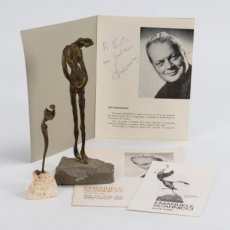Scarnicci Bronze Sculptures
€ 0,00
Bronze Sculptures by Scarnicci
EMANUELE SCARNICCI (BORN 1916), BEELDHOUWER
Brutalist manner sculptures )*
Emanuele Scarnicci maakte bronzen sculpturen in zijn atelier in Florence.
De techniek van Scarnicci munt uit zich door de zijn vakmanschap en het zoeken naar details.
Scarnicci's werkt instinctief, zijn sculpturen onderscheiden zich door de kracht die de vingerafdrukken van de vingers aan de was gaven.
Hij signeerde vaak alleen met zijn achternaam.
Emanuele Scarnicci was born in 1916. Artists Leonard Manasseh, Carl Jutz, Bruno Guidi, Wim Noordhoek, and Arno Lemke are of the same generation
Emanuele Scarnicci was largely inspired by the 1930s.
Emanuele Scarnicci was a painter but is best known of his unique bronze sculptures made in the 60's/ 70's.
Does that mean that the art is unfinished looking? Not exactly. I would say in a similar vein to mid century modern designs, the artwork does not have many added ornamental frills or stray from the basic form of the design.
The period of the 1930s is characterised by the conflict between many political ideologies, including Marxist Socialism, Capitalist Democracy, and the Totalitarianism of both Communism and Fascism.
Artistic output in the United States was heavily impacted at the time by the Great Depression, and a number of artists took to focusing on ideas of modesty and the ordinary man.
For the first time in US history, artists began to delve into political subjects and attempted to use their art to impact society. Themes including poverty, lack of affordable housing, anti-lynching, anti-fascism, and workers' strikes were prevalent in many artists’ work.
In the Soviet Union, Stalin’s government needed urgent funds to implement the rapid industrialisation demanded by the first Five Year Plan.
It initiated a secret proposal to sell off treasures from the State Hermitage Museum in Leningrad (St. Petersburg), including a primary list of two hundred and fifty unique paintings by the Old Masters, a number of which found their way to the collection of Andrew Mellon via the New York based art dealing company, Knoedler. Surrealism continued to dominate in Europe, and had influence worldwide.
Artists such as Frida Kahlo and Diego Riviera in Mexico, worked to integrate the ideas posed by Surrealism into their revolutionary political philosophies, developing a new kind of magic realism.
The decade took a threatening turn with the birth of National Socialism in Germany, followed by Adolf Hitler’s rise to power in 1933. By the end of the 1930s, the Second World War had begun; which preoccupied both artists and the global population.
The process that Scarnicci used is called cire perdue (lost wax metal casting). Using this method of sculpting allowed for no duplication. Each work is unique and one of a kind.
Emanuele Scarnicci's work has been offered at auction multiple times.
Bronze is an ideal medium favoured by sculptors because of its durability, versatility and aesthetic appeal. The metal is composed of copper and tin (in an 88:12 ratio), which are melted and combined to create the desired alloy.
Bronze statues are typically made through the casting process when molten bronze is poured into a mould and allowed to cool and harden. Once the statue has cooled, it is removed from the mould, and the artist can then add the finishing touches, such as polishing the surface.
Unlike chiselling a piece of stone or marble, the casting process allows for a much more precise and consistent recreation of the artist’s original design.
)*
What is brutalist art sculpture?
Merriam Webster defines brutalism as "a style in art and especially architecture using exaggeration and distortion to create its effect (as of massiveness or power)."
From what I have seen of brutalist style metal artwork, there is often a raw, jagged or simple, organic form to the pieces. Does that mean that the art is unfinished looking? Not exactly. I would say in a similar vein to mid century modern designs, the artwork does not have many added ornamental frills or stray from the basic form of the design.





